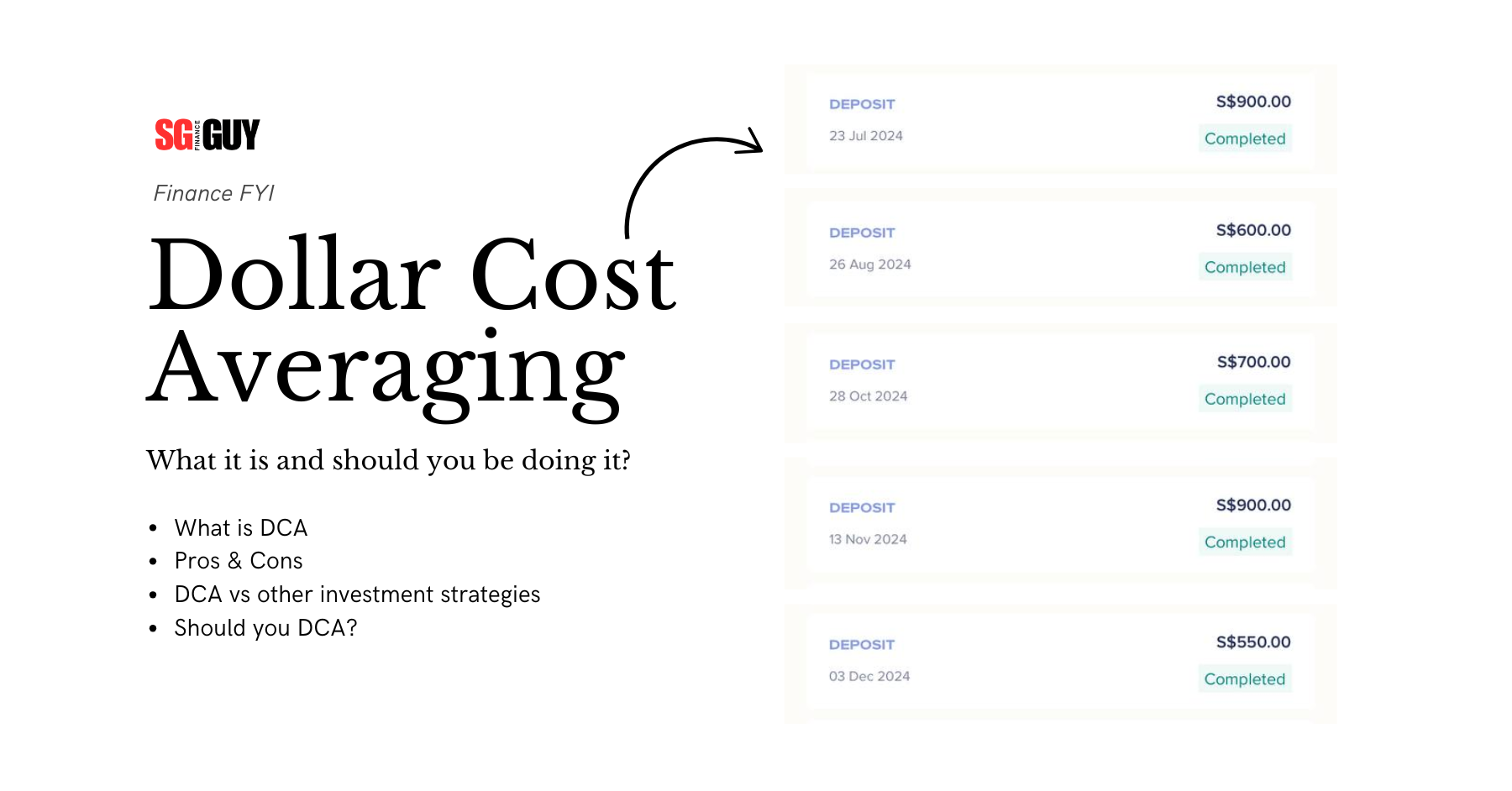Have you ever been burned badly in the stock market before? Bought into a stock while it was all the hype and everybody around you – your uncles, aunties and even your hairdresser – were raving on and on about it going to the moon?

Only for it to nosedive sharply after you buy it, leaving you a nervous, unhinged mess as it continues merrily on its downwards trajectory?
I’ve been there. When I was an inexperienced and impressionable young adult, I lost a significant chunk of my savings to the merciless stock market. Actually, for transparency’s sake, it wasn’t the stock market that ate a majority of my savings but the crypto market.
Looking back, I had nobody to blame but myself. I was impulsive. I did not exercise proper judgement. And I was blinded by greed and promises of wealth beyond one’s imagination.
Still, while it was painful and entirely avoidable, it served as a lesson that I remember till this day.
To never try and time the market again.
This affirmation led me to the discovery of a strategy known as DCA, or dollar cost averaging. I haven’t looked back since implementing this as my primary investment strategy.
In this post, I’ll be breaking down the concept of Dollar Cost Averaging, explaining its pros and cons, and how it compares to other popular investment strategies. All while keeping the explanations and terms used as simple as possible.
What is Dollar Cost Averaging?
Dollar Cost Averaging refers to the act of investing at fixed intervals regardless of market conditions.
At the most basic level, with stocks and a typical salaried worker as an example, it’s essentially buying more of the stock you’re invested in the moment your monthly salary comes in.
Let’s take me for instance! My pay comes in on the 28th of every month. I make it a point to immediately deposit some money into my brokerage and purchase more shares of stocks that I own.
Rain or shine, up or down, I’m buying those damn stocks.
It doesn’t matter if the market took a fat dump because the Feds sent a cryptic message about “not being where they want to be at” yet. It doesn’t matter if the market already rallied because a mysterious masked individual with a moniker that rhymes with soaring city tweeted a couple of pixels. It doesn’t matter if a political figure that recently took office decides to proverbially stick something spherical up everybody’s bottoms with the “most beautiful word” in the English language.
I stick to the same ol’ strategy and pay no heed to what’s going on around me.
That’s Dollar Cost Averaging in a nutshell.
TL;DR: Dollar Cost Averaging is essentially investing consistently at fixed intervals without consideration of external market factors.
Why should I Dollar Cost Average?
Good question. It sounds ridiculously simple… too simple even. Shouldn’t investment strategies be elaborate and complex and all that jazz?
Well, there’s beauty in simplicity. Here are the main reasons why you should consider DCA-ing.
1. Reduces Risk of “Timing”
Envision this. You happen upon a sizable chunk of money. It could be through inheritance, a thirteenth-month bonus or every Singaporean’s wet dream, toto winnings. You don’t want to keep the money on hand. You intend to invest it all in one shot.
This is known as lump sum investing.
With lump sum investing, which is essentially the antithesis of DCA, the timing of which you invest is of utmost importance. If you get in at the lowest point in the market, your returns will be exponentially higher than if you get in at the highest point. And since the markets are largely unpredictable, it’s mainly guesswork on whether a certain stock has hit a new high or bottomed out.
Take this scenario for example. If you had decided to invest a lump sum in December of 2021, you would have been in a world of hurt. The market crashed shortly after due to inflationary concerns and the Feds pulling back on loose post-COVID monetary policies. Assuming you didn’t invest anymore past that point, it would have taken a whopping 2 years for you to recover from the losses you incurred and reach breakeven.
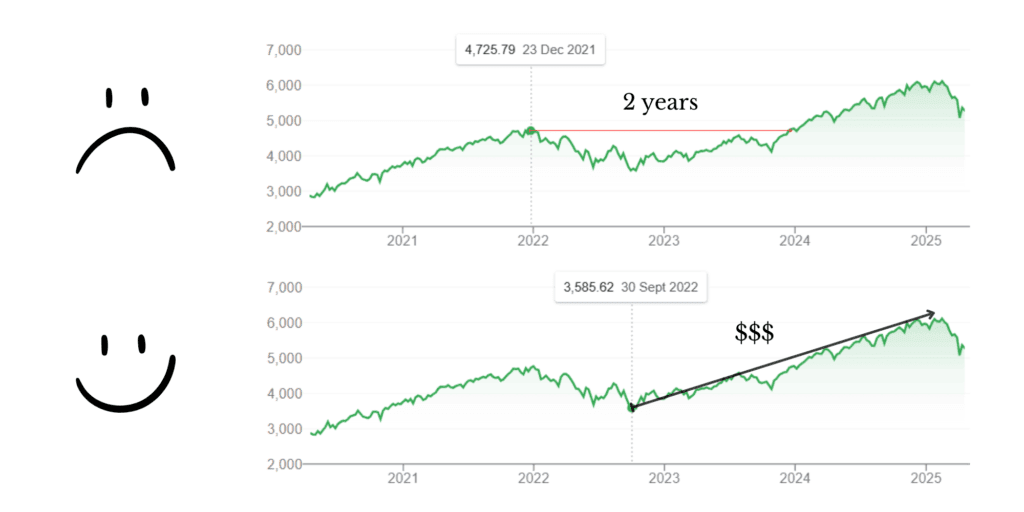
However, if you got really lucky and somehow invested the lump sum in the September of 2022 instead, your portfolio would have performed superbly without a single day in the red.
That’s the risk of timing. And from the charts above, it’s easy to see that the role it plays in determining your return on investment cannot be understated.
However, with Dollar Cost Averaging, you don’t face any of the above issues since you invest at a fixed interval like clockwork. Timing doesn’t matter in this case when you average out the cost of each share of stock you own in the long run.
As the cherry on top, you bypass all the time-consuming research needed to determine if it’s a good time to invest.

Also, you will find yourself averaging out the cost per share of the stocks you’re holding over the long run, typically leading to steady profits.
P.S. This is not to say lump-sum investing isn’t a good strategy. More on this later!
2. Builds Discipline
Research shows that it takes an average of 66 days to build a habit.
Just like going to the gym or reading regularly, you should think of investment as something you want to make a habit out of.
Think about it – at their very core, the former two are essentially forms of investment as well. You put in your time and effort and get certain benefits such as confidence, knowledge and health in return.
Investing is for your financial health with a much, much more tangible and literal return on investment.
This might be more of an issue for investors who are just getting started, but staying disciplined to investing is criminally underrated.
Many people get cold feet the moment the market crashes. Once bitten, twice shy. While I understand it’s scary to put your money into anything that’s down in the dumps, this is where your discipline should kick in. Grit your teeth, keep your head down and just go through with it. If you’re not going to skip a gym session when you’re having a shitty day, why are you not investing just because the market is looking a little blue?
Dollar Cost Averaging really shines through in such cases. It’s simple to follow and you can stick to your strategy without much thought. It’s easy to be disciplined if you know you have a strategy that’s time-tested and historically proven to be highly effective.
The rewards are reaped by those who work hard (in this case, smart) and stay consistent.
3. Reduces Emotion
You know how in the wee hours of the morning, after a night out with your friends and a couple of drinks, you have the tendency of letting your emotions get the better of you? Alcohol lowers your inhibitions, intensifies your turbulent emotions, and… you end up making some truly questionable decisions.
Like texting your ex and asking for reconciliation.
Or caving in to peer pressure and agreeing to another round of drinks despite having made plans to go to JB early tomorrow morning.
Or selling all your crypto in the heat of the moment because you’re down 67% and your heart couldn’t take it anymore.
No, I’m not speaking from experience. I swear.
But I digress. My point is… emotion often results in bad decisions. We are humans, and humans are naturally emotional creatures. Even the most stoic of men will falter when confronted with large red numbers on their screens, knowing that they have lost a significant chunk of their life savings.
It doesn’t help that the stock market typically follows a cycle of emotions starting with strong returns when optimism is high, and peaking with widespread euphoria. Then, a string of negative events shatter confidence and fear creeps in, resulting in mass sell-offs. The cycle then repeats itself when the dust settles and the markets slowly recover.

The thing is, if you’re that typical investor and the chart above depicts your investment behaviour to the tee, I don’t need to consult a crystal ball to know that your returns – if any – aren’t ideal.
This is why Dollar Cost Averaging is viewed in such high regard.
Since you’re depositing and investing money at regular fixed intervals without caring about the state of the market, you’re not allowing your emotions to cloud your judgement. You’re always cool, calm and collected. You stick to your strategy. You buy at fixed intervals. This means that you buy more shares of the stock when the market is in the dumps and buy less shares when the market is near the peak.
Admittedly, the latter isn’t ideal, but in the long, long run, it all evens out. Also, it’s the trade-off you get for more stability – both financially and mentally.
Always remember this famous saying by the Godfather of investing.
“Be fearful when others are greedy, and greedy when others are fearful.” – Warren Buffett
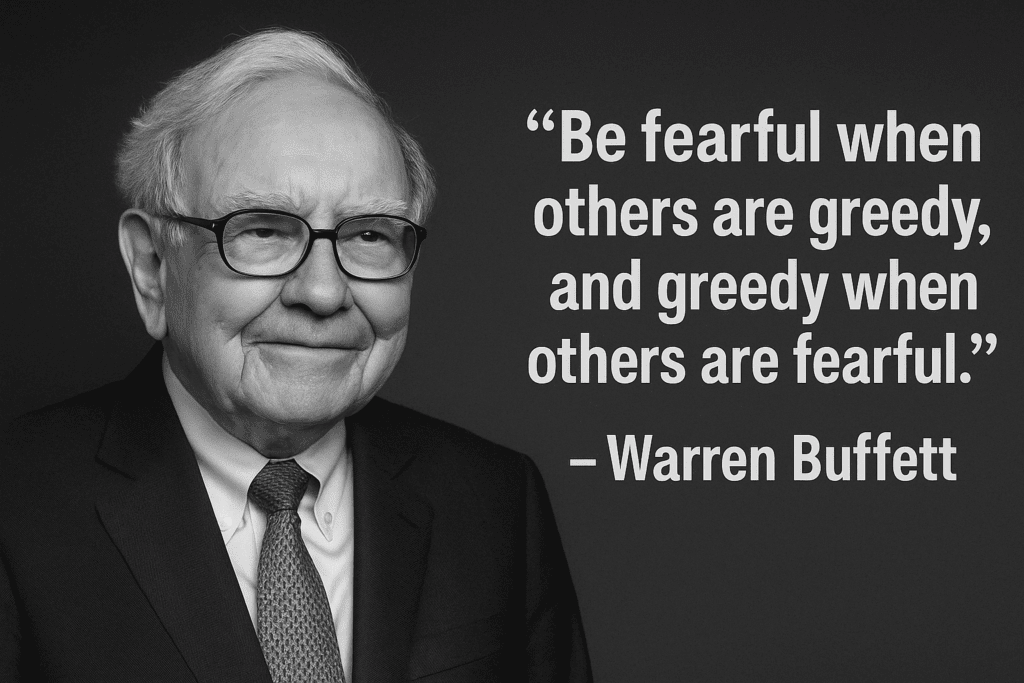
DCA is pretty much the ideal strategy to employ to achieve that with minimal effort on your end.
Drawbacks of DCA-ing
Now that I’m done waxing literal poetry and singing praises about DCA, let’s move on to the cons. Yes, unfortunately, there’s no “perfect” investment strategy. Even though I believe DCA comes as close as possible to perfection (I might be a lil bit bias here), there are still some drawbacks you need to be aware of.
1. Higher Transaction Costs
The most obvious downside of DCA-ing is the transaction costs you’ll incur making the stock purchases on such a regular basis versus a one-time transaction. Most brokerages charge some sort of fee to buy a stock through them, be it platform, trading or commission. This could be a flat sum or a percentage-based cut, depending on the amount you’re trading. On top of this, there are other “hidden” fees such as fx (currency exchange) and spreads – all of which accumulate and add up over a long period of time.
2. F*cks Asset Allocation
Diversification is the name of the game. All big-name investors swear by it (crypto doesn’t count, I don’t particularly care for crypto billionaires who got lucky hedging their life savings on $SHIBA) because it helps to lower risk.
Some people diversify by buying different companies. Some people take it a step further by buying different companies in different industries. Some people take it two steps further by buying different companies in different industries across numerous geographies.
And on top of all of that, you can take it another step further by buying and investing in different asset classes (on top of the commonly traded stocks, known as equities or securities), such as bonds and properties.
Now, a good example of a diversified portfolio with different asset classes is Ray Dalio’s All Weather Portfolio.
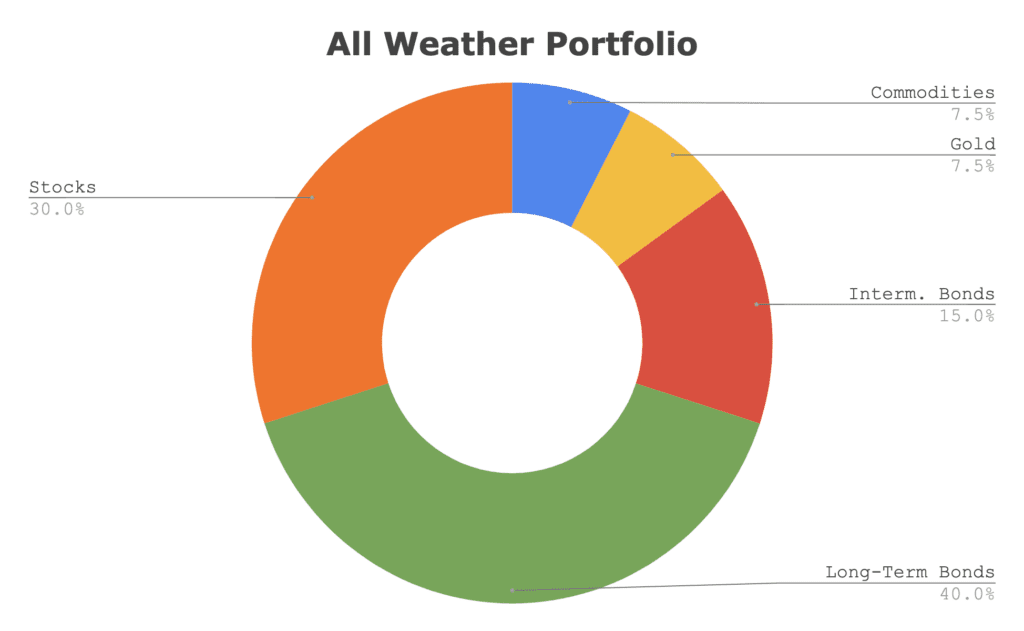
Not going to talk too much about this as this is another topic altogether, but note how there are different allocations to each asset class?
DCA makes it hard to stick to this allocation as you’ll need to deposit a specific percentage of your availing funds into each asset class whenever you decide to make a deposit. And… well, unless you’re depositing a crazy sum of money each time, there will be problems. We’re talking inability to meet minimum investment sums, high fees, ever-changing hoops and criterias to qualify…
The list goes on and on.
3. Lower Expected Returns
Now, as a huge advocate of Dollar Cost Averaging, this fact initially blew my mind. Now that it’s been a couple of years and I have learned more about finance, not so much.
DCA has historically underperformed lump sum investing. According to Vanguard’s research, from 1976 to 2022, lump sum investing would have outperformed DCA 68% of the time.
The reason is extraordinarily simple.
The market spends more time going up than down.
Bull markets—periods of rising prices—last on average 6.6 years, while bear markets—periods of decline—last just 1.3 years. That means if you drop a lump sum into the market at any random point in time, odds are you’re doing it during a bull market. And since bull markets last longer, your money starts growing and compounding sooner, potentially capturing more of the upside than if you had gradually trickled it in over months through DCA.
This chart below included in Vanguard’s study might help you with visualizing this.

In this hypothetical scenario above, you DCA-ed your capital monthly across a period of 3 months. That means you only have 9 months of being fully invested in the market as compared to the 12 months if you had committed to Lump Sum Investing.
Now, since we’ve established it’s more likely that the market is bullish rather than bearish at any random point in time, you’ll get better returns if you stay fully invested for longer.
But hold your horses! Before you go running off to dump every last bit of your savings into Tesla, you’ll want to read the next portion first.
Is Dollar Cost Averaging the best investment strategy?
The million dollar (quite literally) question. Which is the best investment strategy?
In the previous section, we established that Lump Sum investing wins out over Dollar Cost Averaging 68% of the time.
But here’s what I didn’t touch upon in the previous section. The 32% of the time when DCA outperforms Lump Sum investing.
In the cases where DCA wins out over Lump Sum investing, it’s usually because the market turns south shortly after you invest. That’s what happened in late 2021 or early 2022, for example. A lump sum investor at the start of that year would’ve faced immediate losses, while a DCA investor could’ve bought in at cheaper prices as the market declined, averaging out the cost of each stock until the market finally recovers. (Remember the chart above under the risk of timing section? Exactly!)
Which leads me to my next point… DCA shines during times of uncertainty.
DCA is often viewed as the emotionally smarter and risk-sensitive strategy as it’s the safest and least mentally taxing investment strategy to navigate turbulent markets. And judging by how volatility looks to be the theme for 2025 (and for the rest of Trump’s presidency, if the first few months of his term were anything to go by), I would say that it’s as good a time as ever to adopt DCA.
With all that being said…
There’s no such thing as a perfect strategy. Yeah, I know, I know, that’s the most generic statement ever, one repeated by investment firms and finance experts all over the world. But it’s true.
The superior investment strategy depends on a multitude of factors, including but not limited to:
- Your investment horizon
- Your risk tolerance
- Your investment goals
- Your sensitivity to market fluctuations
- Your desired asset allocation
The list goes on and on. Ultimately, it’s really up to you – every strategy has its pros and cons after all. It’s just which one will better suit your needs and make it more convenient for you to invest.
However, rather than leaving it as that like most other finance blogs do, I’ll like to present a couple of scenarios featuring different investment strategies to paint a picture that could be easier for you to understand.
DCA vs Lump Sum vs Fixed Deposits
There are 4 friends: Ah Beng, Ah Seng, Ah Lian and Ahmad. They all decided to start investing at the same time on the 1st of January, 2015 with a total deployable capital of S$100,000 each.
Ah Beng recently moved into his new BTO with his secondary school sweetheart. With a loan to repay and plans to have kids soon, Ah Beng understands that liquidity is important as he might need money in the near future if some unexpected expenses pop up. It will also help to pay for his siamdiu escapades. Because of this, he decides to DCA his capital into the S&P500 at $10,000 every year for 10 years.
Ah Seng is your typical high-flying insurance agent. He leads a bachelor’s lifestyle and has no plans of settling down in the near future. He has a steady stream of income from his job and is confident that he won’t ever need to touch the $100,000 in the next couple of years. He decides to invest the entirety of that sum into the S&P500 in one go.
Ah Lian has no clue what investing is. She has also heard lots of horror stories from her friends who have lost hundreds of thousands in crypto and believes that investing is bad. However, her second boyfriend works as a financial advisor and insists that she shouldn’t be keeping her $100,000 in cash as it depreciates every year due to something called inflation. She relents but being the kiasi queen she is, she firmly states that she refuses to invest in anything remotely risky. The $100,000 was subsequently invested in SSBs, otherwise known as Singapore Savings Bonds.
Ahmad doesn’t know why he’s in this friend group in the first place. He has a sneaking suspicion he was recruited as a “diversity hire”, but he doesn’t know for sure. One thing he knows for sure though is that his luck is terrible. Whenever he buys a stock, it immediately plummets in value. Whenever he sells a stock, it immediately rises in value. However, despite being gan suey, he still invests because he’s a live in the moment kinda guy. He also employs the DCA strategy by investing $10,000 every year over 10 years, but the difference is he only buys into the market at the highest point each year.
Here’s how their returns look after 10 years on the 1st of January, 2025.
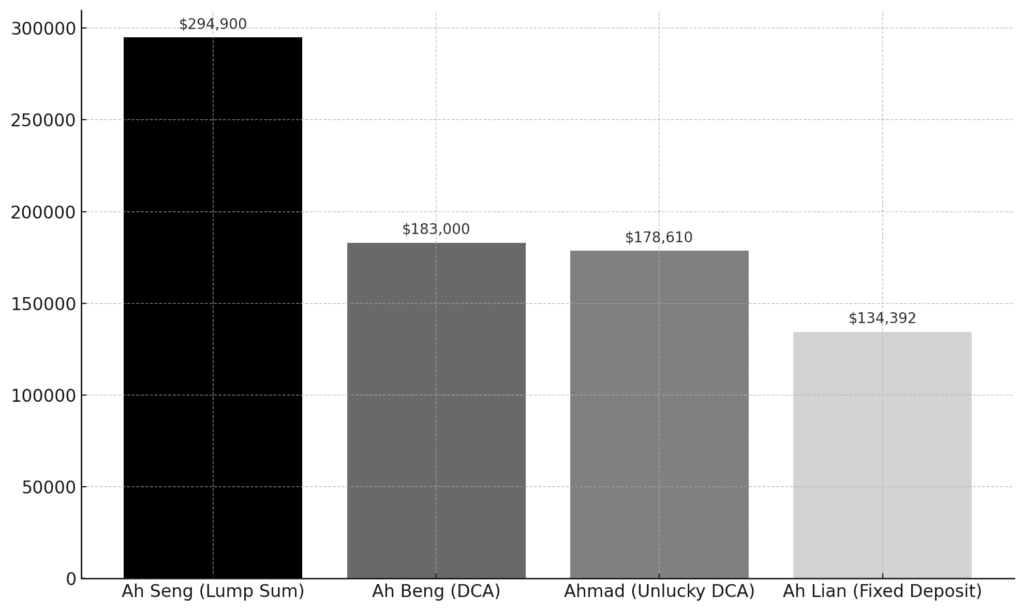
It might not come as a surprise that Ah Seng had the best returns among the four with a whopping 195%. After all, lump sum investing outperforms DCA 2 out of 3 times and the difference becomes more and more apparent the longer the time period. To be entirely fair, this fictional character was also incredibly lucky as the S&P500 enjoyed unprecedented levels of growth during this period.
But enough with Ah Seng – let’s move on to Ah Beng. Our resident DCA enthusiast didn’t do too shabby with 83% returns. Sure, it pales in comparison to Ah Seng, but he did significantly better than Ah Lian.
Speaking of Ah Lian, she played it safe and only managed a 34.3% return. Not the best, but at least it’s still better than keeping it in cash. If she hadn’t invested at all, the value of the initial $100,000 would have dropped to $82,000 at the end of the 10 years, assuming an average annual inflation rate of 2%.
Perhaps unexpectedly, for all his bad luck, Ahmad actually didn’t do that much worse than Ah Beng with a mere 5% difference in returns. This simply shows it pays to be invested and time in the market is better than trying to time the market.

Fun fact: If you missed out on just 5 days during a bull rally, you potentially stand to lose 20% of gains.
So… let’s wrap it up.
If you were only to take away one thing from this article, I would like for it to be that the best investment strategy is the investment strategy that involves keeping your money invested in the market for as long as humanly possible. Regardless whether you decide to go with Lump Sum investing or Dollar Cost averaging, the point is to stay invested and not pull out due to cold feet.
Stick to the fundamentals, and you’ll be fine.
Just remember that building wealth isn’t a sprint, but a marathon. The stock market is a battlefield, and time is your biggest ally.
Until next time!
Stay safe, stay healthy and stay invested.

